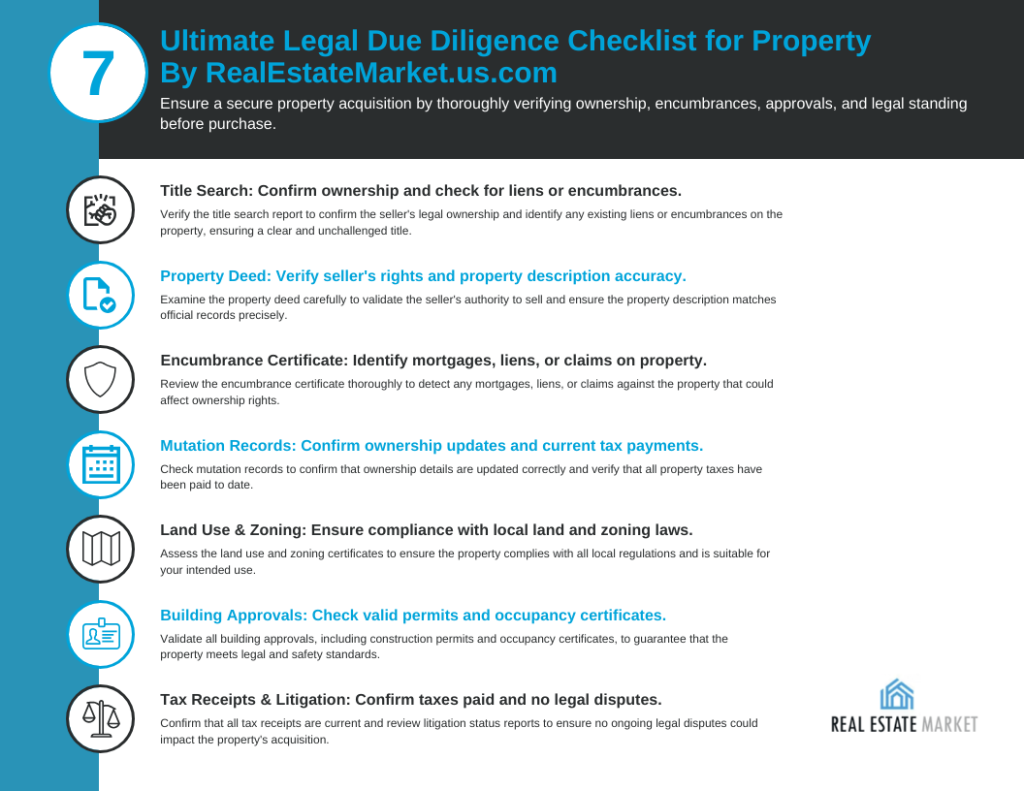Buying a house stands as the biggest and most important purchase you’ll make in your life. A detailed real estate due diligence checklist becomes absolutely essential before you sign those final papers.
The sky-high home prices in today’s market might push you to grab the first decent property you see. This rush to avoid missing out could spell trouble. A buyer’s due diligence checklist helps prevent nasty surprises after the property changes hands.
You need a systematic approach to due diligence. Without it, delays and oversights can derail your purchase process. Many due diligence items serve as contingencies for closing the purchase. These contingencies let you walk away and get your money back if things don’t check out.
This piece walks you through a bulletproof real estate due diligence process. We cover everything from ownership checks and financial reviews to environmental assessments and legal matters. You’ll gain the knowledge to tackle your next property purchase with confidence.

Verify Ownership and Legal Standing
Your real estate due diligence journey starts by verifying the property’s legal owner. This crucial first step helps you avoid pricey disputes and protects your investment from future problems.
Check seller authorization and entity documents
The seller must have legal authority to transfer the property, which requires detailed document verification. You should request the seller’s authorization document that confirms their right to sell or authorizes someone else to act on their behalf during closing. You should also get into the certificate of title, which formally states the seller’s ownership rights. Business-owned properties need company formation documents to verify proper transaction authorization.
Review title report and legal description
A detailed title report shows who owned the property and flags potential problems that might affect your rights. Your due diligence should include checking title search results for hidden liens, easements, or encumbrances. The legal description becomes especially important because it shows the exact location and property boundaries. Street addresses don’t work like legal descriptions, which courts use to solve boundary disputes. Note that assessor parcel numbers (APNs) don’t provide enough legal identification since they change by county and might not match actual property lines.
Confirm zoning and land use compliance
Real estate’s biggest problem happens after closing when you find out you can’t use the property as planned. You need current zoning verification to avoid this. Ask for a zoning report that shows if the property’s current use and structures follow local rules. Look for any special permits or variances. The current use doesn’t always mean compliance – violations often surface only during property transfers. Larger parcels over 10 acres might need extra government reviews for use changes in some areas.
This ownership and legal verification creates a strong foundation for your real estate due diligence checklist. You can move confidently to financial reviews after completing these steps.
Review Financial and Contractual Obligations
The financial aspects of your potential property need a close look after you establish clear ownership. A Property financial review is a vital part of any real estate due diligence checklist that protects you from surprise costs and obligations.
Analyze rent rolls and lease agreements
Rent rolls are key documents that show tenant information, lease terms, rental amounts, and income summaries. Investors can calculate net operating income and internal rate of return with this united view. Lease agreements need careful review to check terms, rent escalation clauses, tenant rights, and conditions to end the lease. You should look closely at Common Area Maintenance (CAM) charges, property tax obligations, and repair responsibilities because they often hide extra fees.
Review tax records and financial statements
Property taxes are usually the biggest expense item on a property’s operating statement. In spite of that, buyers don’t analyze this cost enough during due diligence. So, unexpected tax hikes can affect operating costs and property value by a lot. You should ask for income statements from the last three years to see revenue patterns and expense statements that cover maintenance, utilities, and management fees. Take time to review current assessed values, tax rates, exemptions, and past tax appeals.
Check for outstanding debts or liens
Finding hidden liabilities is a key step in your due diligence process. You need to do a full lien search to spot any claims against the property. Note that buying a property with a lien means that obligation becomes yours, which could lead to foreclosure or legal issues. On top of that, it helps to check all mortgage information, existing loans, and look through litigation history for any ongoing legal actions.
Evaluate service contracts and insurance policies
Service contracts help manage properties by taking care of maintenance tasks and repairs quickly. Make sure to review existing agreements for cancellation clauses, possible penalties, and ongoing obligations. Insurance policies are valuable corporate assets that directly affect risk assessment and deserve careful attention. Look at coverage terms, liability limits, self-insured retentions, and exclusions to see if they match identified risks.
Inspect Environmental and Physical Conditions
Physical inspection is a vital part of your real estate due diligence checklist. It helps identify environmental hazards that could affect property value and keep occupants safe.
Conduct Phase I and II environmental assessments
Phase I Environmental Site Assessments review current and historical property uses to spot potential contamination risks. This assessment has record reviews, site visits, interviews with knowledgeable parties, and looks at historical documentation. A Phase II assessment becomes necessary if Phase I finds recognized environmental conditions (RECs). Phase II tests soil, groundwater, or building materials samples to confirm if contamination exists and how far it extends. These assessments help buyers avoid cleanup liability under CERCLA (Comprehensive Environmental Response, Compensation and Liability Act).

Review property condition reports
Property Condition Reports (PCRs) give a complete picture of a building’s physical structure and systems. Qualified professionals create these reports to find existing problems, delayed maintenance, and future expenses. A full PCR looks at structural components, mechanical systems, electrical systems, plumbing, roofing, interior finishes, and site improvements.
Check for hazardous materials like asbestos or lead
Lead-based paint might be present in properties built before 1978, and only certified professionals should inspect them. Homes built before the 1980s usually have asbestos in their insulation, roofing, flooring, and textured ceilings. These materials can be dangerous to health when disturbed during renovation or demolition because they release harmful fibers into the air.
Inspect utilities and infrastructure access
Infrastructure access is a key step in due diligence. You should review utility easements that could limit construction options and check access to water, electricity, and sewage systems. This review helps you understand extra development costs and how you might be limited in using the property.
Assess Legal Risks and Final Approvals
Legal risk assessment plays a crucial role in the final stage of property acquisition to protect your investment from unexpected issues.
Identify pending litigation or regulatory issues
Certificates of Pending Litigation (CPLs) can substantially affect a property’s value and transferability. These legal notifications stay with the property and usually stop ongoing transactions, which creates uncertainty for buyers. Court searches help uncover judgments and pending litigation, while real property filing office searches show judgment liens. You should break down any ongoing or past litigation with the property or its owners to spot potential financial or legal risks.
Review purchase agreement and contingencies
Your purchase agreement forms the backbone of the transaction. Each contingency protects you by tying the deal to specific conditions. These clauses are a great way to get legal protection, letting buyers exit without losing their earnest money deposit if conditions fail. However, too many contingencies could make your offer less attractive in competitive markets.
Ensure all due diligence documents are complete
You need to verify these essential documents:
- Existing lease agreements and terms
- Service contracts and management agreements
- Insurance policies and pending claims
- Regulatory filings, permits, and consents
Finalize buyer due diligence checklist before closing
A detailed checklist should track each completed step during this process. This strategic approach helps teams line up and complete the process confidently. Remember to resolve any identified issues before moving forward with the investment.
Conclusion
Real estate due diligence protects what could be your life’s biggest investment. This piece explores the key parts of a complete due diligence process. Without doubt, title reports and legal documentation are the foundations of your property assessment.
Your financial review is a vital part of due diligence. You need to analyze rent rolls, tax records, and outstanding debts to understand ownership’s true cost beyond the purchase price. This careful review stops unexpected expenses from turning a good deal into a financial burden.
Physical and environmental assessments need equal focus during due diligence. Property condition reports, environmental checks, and hazardous material inspections protect you from expensive remediation costs. These steps can save thousands of dollars and prevent countless problems after closing.
Legal risk assessment completes your due diligence process. You should check for pending litigation, review purchase agreements, and ensure complete documentation before finalizing your investment.
Note that rushing through due diligence under market pressure might seem right now but leads to regrets later. This systematic approach helps you move forward with confidence instead of doubt.
This foolproof real estate due diligence checklist gives you tools to handle your next property purchase with method and care. Your future self will appreciate the time spent on this vital process. Successful real estate investors aren’t the ones who move fastest – they’re the ones who do their homework before signing the deal.
Key Takeaways
Master these essential due diligence steps to protect your real estate investment and avoid costly surprises after closing.
• Verify ownership thoroughly – Check seller authorization, review title reports, and confirm zoning compliance before proceeding with any purchase.
• Analyze all financial obligations – Examine rent rolls, tax records, outstanding liens, and service contracts to understand true ownership costs.
• Conduct comprehensive property inspections – Perform Phase I/II environmental assessments and check for hazardous materials like asbestos or lead.
• Assess legal risks systematically – Identify pending litigation, review purchase agreement contingencies, and ensure all documentation is complete.
• Use contingencies as protection – These clauses allow you to walk away and recover your earnest money if conditions aren’t met during due diligence.
Remember, rushing through due diligence due to market pressure can lead to devastating financial consequences. The most successful real estate investors aren’t the fastest to act, but the most thorough in their preparation. A systematic approach to due diligence transforms uncertainty into confidence, protecting what may be your largest lifetime investment.

